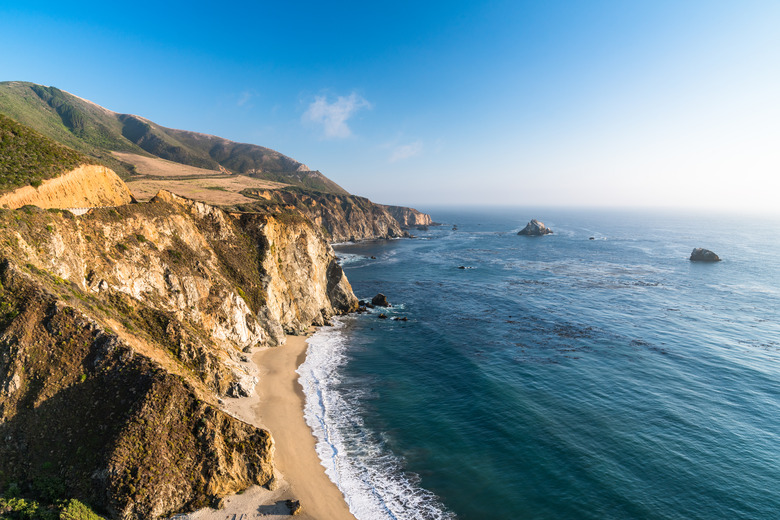Abiotic Factors Of The Coastal Ocean Zone
Abiotic factors are the non-living things that affect an ecosystem. When one of these factors changes, there is typically a positive or negative impact on the life forms of the area. The coastal zone — the area of the ocean that is near land — has a number of factors that contribute to the continued survival of the delicate ecosystems within. The abiotic factors in the ocean also factor into the coastal environment.
Read more about the definition of abiotic and biotic factors.
Temperature
Temperature
Among the most critical abiotic factors examples is temperature. The temperature of a geographic area affects the temperatures of the waters that are found off its coastal regions. Any changes in these abiotic factors in a marine ecosystem or a coastal ecosystem is likely to impact the species that make their homes in these waters. Marine animals such as fish are particularly sensitive to temperature with many species requiring waters within a certain range.
Among the most affected by changes in temperature is the species that makes up the backbone of one of the most important coastal ocean zone ecosystems — coral. If the average temperature of the ocean rises just a few degrees over a season, it can result in the the loss of nutrients and microscopic organisms the coral depends on for survival. Prolonged temperature change can result in mass deaths of coral.
Sunlight
Sunlight
Sunlight is one of the most basic building blocks of life on Earth, which also makes it one of the most important abiotic factors examples for all ecosystems, including coastal and marine ecosystems. Because water blocks sunlight, the area of the ocean that is most capable of supporting life is the coastal ocean zone. This shallow zone still receives enough sunlight to support plant — and in turn animal — life. The deeper into the ocean sunlight travels, the more diluted it becomes; at 3,000 feet, there is no sunlight.
About 90% of all marine life exists in this sunlit zone and all of the coastal ocean zone is included in this. Here, there is enough sunlight to support the process of photosynthesis in the plants that live here, which in turn provide food and shelter for the ecosystem's animals.
Macronutrients
Macronutrients
Macronutrients are compounds that are required for all life to survive. Nitrogen, phosphorus and potassium need to be present in order for plants to absorb these nutrients and then convert them into energy that fuels the most basic life processes. When there is a balanced amount of these nutrients available in the water of the coastal ocean zone, the ecosystem is in balance.
When higher than usual amounts of these nutrients are introduced to the water — typically through improper agricultural practices and fertilizer application — it can cause plants to begin to grow faster than desired. Algae is one of the first plants to be affected by a change in the amount of these nutrients, and algal blooms can cover the surface of the water, blocking sunlight from other plants and animals and strangling the life below.
Soil
Soil
While you might not think of soil as one of the more important abiotic factors in a marine ecosystem, many of the coastal ocean regions' plants grow rooted in the soil. Seagrass and reeds grow in the soils of the seabeds, providing food and shelter for a number of the fish and crustaceans that live there. These plants get some of their nutrients from the soils, and as they are so close to the shore, nutrients are in part recycled by runoff.
Erosion can severely impact a coastal water ecosystem, uprooting plants, shifting soils and displacing animals. Erosion introducing new soils to an ocean ecosystem can cloud the water and make it difficult for fish to filter water. Some marine plants, such as seagrasses, act as a natural filter to trap sediment in their roots.
Read more about the coastal ecosystem.
Cite This Article
MLA
Durkee, Debra. "Abiotic Factors Of The Coastal Ocean Zone" sciencing.com, https://www.sciencing.com/abiotic-factors-coastal-ocean-zone-8409141/. 22 November 2019.
APA
Durkee, Debra. (2019, November 22). Abiotic Factors Of The Coastal Ocean Zone. sciencing.com. Retrieved from https://www.sciencing.com/abiotic-factors-coastal-ocean-zone-8409141/
Chicago
Durkee, Debra. Abiotic Factors Of The Coastal Ocean Zone last modified March 24, 2022. https://www.sciencing.com/abiotic-factors-coastal-ocean-zone-8409141/
